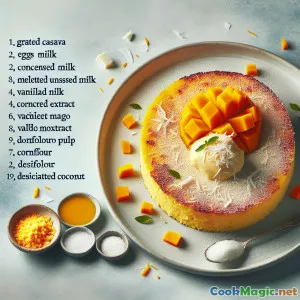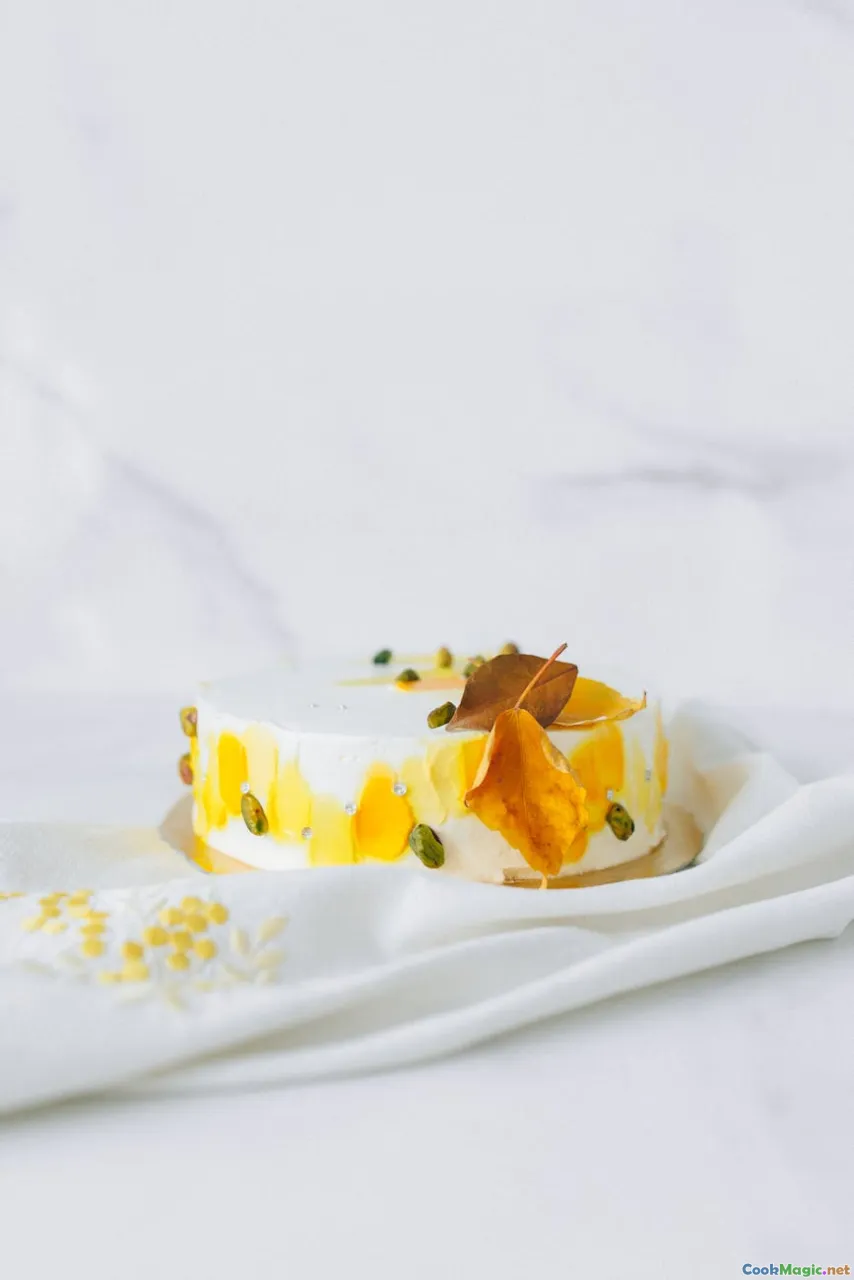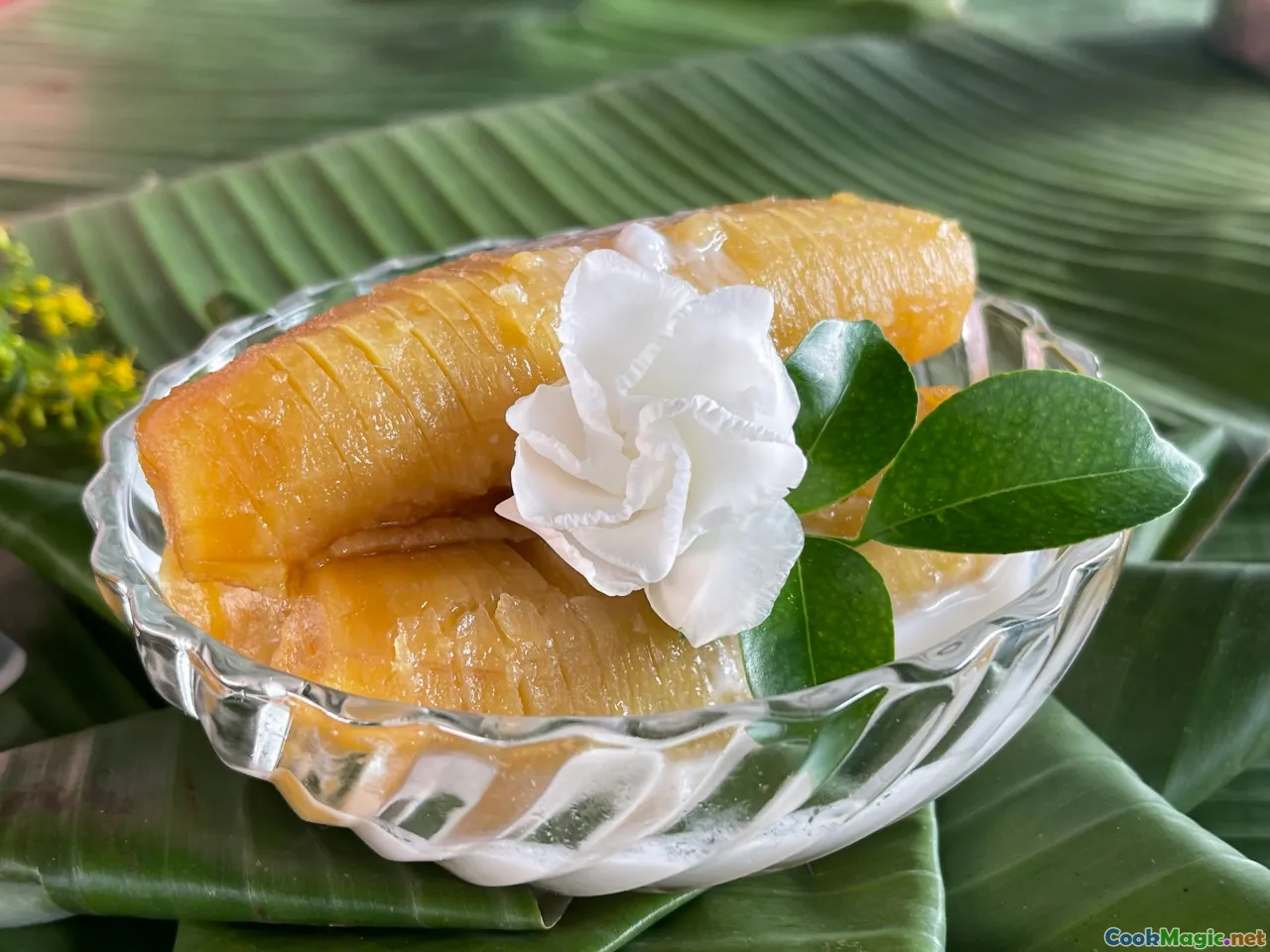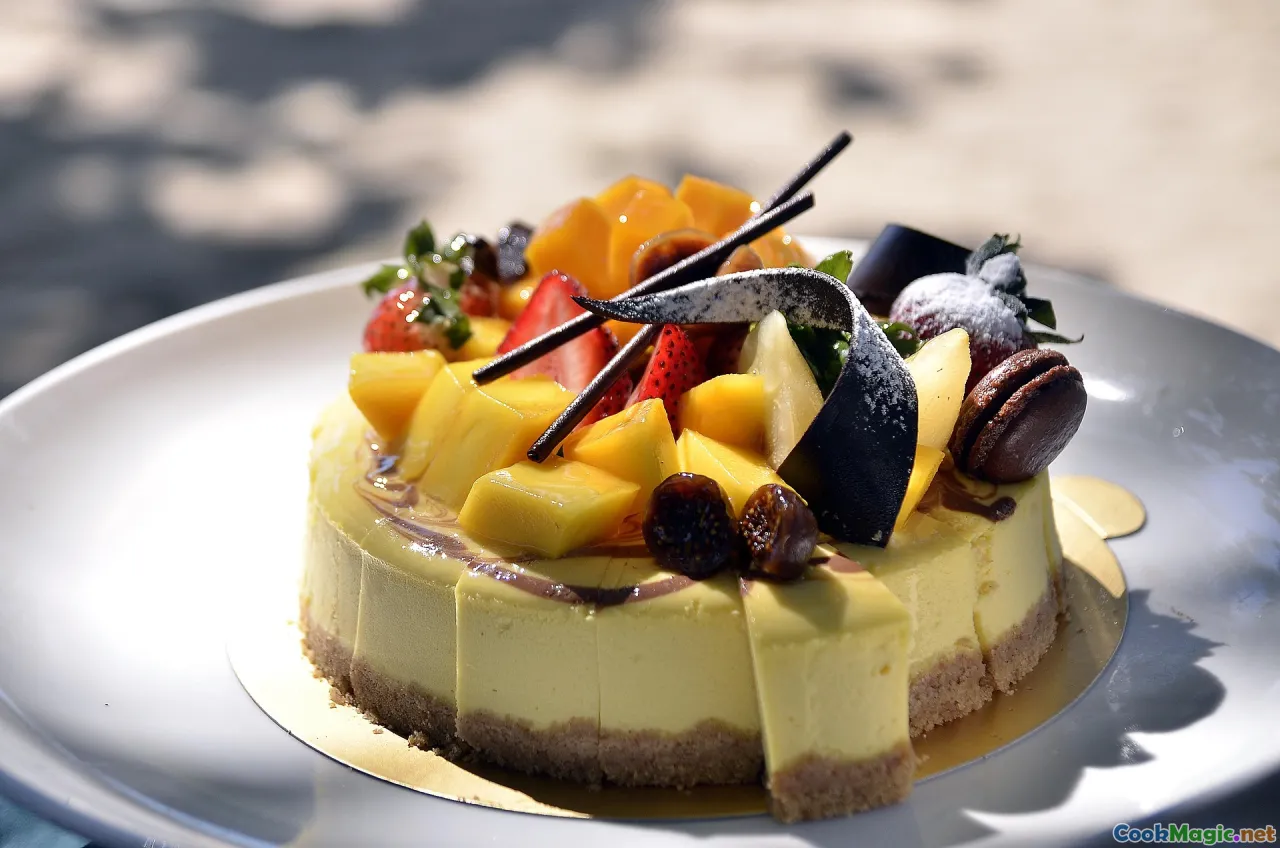
Delicia de Pastel de Yuca con Infusión de Mango Silvestre
(Wild Mango Infused Cassava Cake Delight)
(0 Reseñas)0
3,152
agosto 16, 2025
Informar de un problema
Ingredientes
-
600 grams Yuca rallada (fresca o congelada, descongelada)
(If frozen, drain excess liquid before use.)
-
3 large Huevos
(Room temperature is best.)
-
400 ml Leche de coco
(Full-fat for best flavor and texture.)
-
150 grams Leche condensada
(Sweetens the cake naturally.)
-
80 grams Mantequilla sin sal, derretida
(Adds richness.)
-
100 grams Azúcar glass
(Adjust to taste depending on mango ripeness.)
-
2 tsp Extracto de vainilla
(Enhances aroma.)
-
150 grams Pulpa de mango silvestre
(Preferably unripened for tartness; ripe is sweet.)
-
1 tbsp Maicena
(Stabilizes mango swirl.)
-
1/4 tsp Sal
(Equilibra la dulzura.)
-
2 tbsp Coco deshidratado
(Sprinkled on top for texture.)
(If frozen, drain excess liquid before use.)
(Room temperature is best.)
(Full-fat for best flavor and texture.)
(Sweetens the cake naturally.)
(Adds richness.)
(Adjust to taste depending on mango ripeness.)
(Enhances aroma.)
(Preferably unripened for tartness; ripe is sweet.)
(Stabilizes mango swirl.)
(Equilibra la dulzura.)
(Sprinkled on top for texture.)
Nutrición
- Porciones: 8
- Tamaño de porción: 1 rebanada (120g)
- Calories: 320 kcal
- Carbohydrates: 43 g
- Protein: 4 g
- Fat: 14 g
- Fiber: 2 g
- Sugar: 21 g
- Sodium: 145 mg
- Cholesterol: 52 mg
- Calcium: 63 mg
- Iron: 1.6 mg
Instrucciones
-
1 - Preheat Oven & Prepare Pan:
Preheat oven to 175°C (350°F). Grease a 9-inch square or round cake pan and line the base with parchment paper.
-
2 - Prepare Mango Swirl:
In a small bowl, stir wild mango pulp with cornflour until smooth. Heat gently for 2 minutes in a saucepan to thicken. Allow to cool.
-
3 - Mix Cassava Base:
In a large bowl, mix grated cassava, eggs, coconut milk, condensed milk, melted butter, caster sugar, vanilla extract (if using), and salt until combined.
-
4 - Fill and Swirl:
Pour cassava mixture into the prepared pan, smoothing the top. Dollop thickened mango pulp across the surface. Use a knife or skewer to swirl gently for a marbled effect.
-
5 - Bake the cake:
Bake for 50-60 minutes in the center of the oven till golden on top and just set in the center. Test doneness with a toothpick.
-
6 - Cool & Garnish:
Allow cake to cool in the pan for 10 minutes. Remove, discard lining, cool to room temperature, then sprinkle with desiccated coconut if using.
-
7 - Slice & Serve:
Cut the cake into generous slices, serve on its own or with a dollop of fresh mango or coconut cream if desired.
Preheat oven to 175°C (350°F). Grease a 9-inch square or round cake pan and line the base with parchment paper.
In a small bowl, stir wild mango pulp with cornflour until smooth. Heat gently for 2 minutes in a saucepan to thicken. Allow to cool.
In a large bowl, mix grated cassava, eggs, coconut milk, condensed milk, melted butter, caster sugar, vanilla extract (if using), and salt until combined.
Pour cassava mixture into the prepared pan, smoothing the top. Dollop thickened mango pulp across the surface. Use a knife or skewer to swirl gently for a marbled effect.
Bake for 50-60 minutes in the center of the oven till golden on top and just set in the center. Test doneness with a toothpick.
Allow cake to cool in the pan for 10 minutes. Remove, discard lining, cool to room temperature, then sprinkle with desiccated coconut if using.
Cut the cake into generous slices, serve on its own or with a dollop of fresh mango or coconut cream if desired.
Más información sobre: Delicia de Pastel de Yuca con Infusión de Mango Silvestre
Cassava Cake with Wild Mango: Story, Tips & Insights
The fusion of cassava and wild mango in a tea cake format brings together the best of earthy English baking and the vibrant zest of tropical flavor. Cassava, known throughout the world for its versatility and satisfying dense texture, has long been a staple ingredient in global tropical cuisines such as Southeast Asia, West Africa, and the Caribbean. Yet, English bakers have only more recently embraced it, offering gluten-free alternatives and textural creativity to classic bakes.
Historical & Cultural Significance
While cassava isn’t native to Britain, its arrival via trade and migration brought layers of culinary experimentation to English kitchens. Originally cultivated in South America, cassava quickly spread to Africa and Asia thanks to its adaptability. The buttery, almost pudding-like nature of cassava makes it a luscious base for cakes and desserts, particularly welcoming to modern sensibilities looking for dairy-free, gluten-free, or unique exotic tasting experiences.
Wild mango, meanwhile, packs a more pronounced tartness and aroma compared to its domesticated cousin. In England, mangos evoke both colonial encounters and contemporary fusion cooking trends. For this cake, wild mango’s tang counterbalances the sweet, coconut-tinged richness of cassava, offering flashes of sunshine even on a grey British afternoon.
Unique Aspects and Personal Thoughts
This cake straddles the harmony between "comfort food" and "culinary adventure." It’s moist, dense, and aromatic from coconut and vanilla—a true treat for the senses. The wild mango swirl isn’t just a garnish: it gives the cake a fruity punch and beautiful marbling. Tart mango really lifts the structure, making each bite dynamic and preventing the cake from feeling too heavy.
Traditional English cakes luxuriate in flour and dairy, but here cassava steps in, providing both body and unique flavor. The use of coconut milk evokes memories of the English coconut and jam sponge but takes it one dramatic, tropical step further.
This recipe can accommodate dietary needs—omit the butter and use plant-based condensed milk for a vegan version, or play with different milks like oat or almond for subtle flavor shifts. The batter welcomes gentle inclusions too—diced crystallized ginger or toasted nuts for textural accent, or a citrus zest for added brightness.
Serving the cake cold, at room temperature, or warmed slightly increases its versatility; each way offers a new tactile delight. Leftovers (if any!) keep beautifully in the fridge for several days, actually improving in flavor as the mango settles with the cassava and coconut richness.
Tips & Notes
- Frozen thawed cassava yields beautiful results if fresh isn’t easily sourced.
- For a more pronounced swirl, use semi-ripe wild mangoes—they hold their shape without melting into syrup.
- Take care not to over-bake—cassava cakes set fully as they cool.
- Sprinkle with desiccated coconut, toasted seeds, or crushed pistachios before serving for an elegant finish.
- This recipe also works in a loaf tin, perfect for slicing and adding to elegant dessert platters at afternoon tea.
Final Thoughts
"Cassava Cake with Wild Mango" offers a thoroughly modern flavor journey adaptable for home bakers looking to infuse tradition with innovation. Whether served during a summer picnic in the countryside or as a striking finale to a Sunday roast dinner, it’s a conversation starter—a dessert that pays homage to culinary migrations and connections. If you love cakes with tropical flair and fascinating textures, try this recipe. Your guests will thank you for its uniqueness and bold melding of comfort with surprise.

























